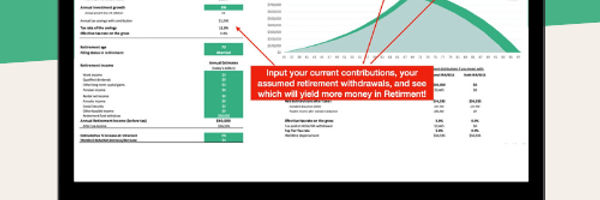There are two related, but slightly different, 5-year rules that apply to Roth IRA withdrawals. The first has to do with earnings on contributions made to an account, while the second has to do with Roth IRA conversions.
In this article, we're going to explain the five-year rules that apply to Roth IRA withdrawals. Once a thorough understanding of these guidelines is gained, it's easier to avoid taking a taxable distribution. Or even worse, a mistake could cost an accountholder a 10% additional tax penalty for an early withdrawal.

Roth IRA or 401k? This template will answer your questions.
With this template, you will get:
All DFY, simply add your details
Charts for comparison and clear answer
Easily update for any year (2023, 2024, 2025, etc…)

Understanding the 5-Year Rules
Additional Resources |
There are two five-year rules that apply to Roth IRA conversions and contributions. Both of these rules affect the tax status of a distribution taken from a Roth IRA. The exact process that applies depends on whether or not the accountholder is age 59 1/2 or older, the distribution was taken from a direct contribution, or it involved an IRA conversion.
Qualified Distributions
The first five-year rule we're going to discuss has to do with the requirements of what are referred to as qualified distributions. The tax law helps the IRS define a qualified distribution. Generally, a payment made from a Roth IRA account is considered a qualified distribution if it meets both of these requirements:
It is made after a five-year period, beginning with the first taxable year after which a contribution to the Roth IRA occurs.
The payment or distribution is made on or after the accountholder reaches age 59 1/2.
Taxpayers have until April 15 of the following calendar year to make a Roth IRA contribution for any tax year. For example, a Roth IRA contribution made in March 2021 for the tax year 2020 starts the five-year clock on January 1, 2021.
A distribution that is not considered a qualified distribution is subject to a 10% additional tax penalty. Keep in mind, that since the money placed in a Roth IRA is an after-tax contribution, these penalties apply to earnings on those contributions, which are normally tax-free when withdrawn. This is one of the big advantages of this type of retirement account.
Roth IRA Conversions
The second five-year rule we're going to cover in this article deals with Roth IRA conversions; or, more specifically, Traditional IRA accounts that are converted into a Roth IRA. Once again, this process has to do with qualified distributions, and an additional 10% tax penalty can apply under certain conditions.
If an accountholder wants to convert a Traditional IRA into a Roth IRA, they must wait at least five years from the first day of the tax year in which they made the conversion before they can take a qualified distribution. For example, if someone converts a Traditional IRA on March 30, 2021, then the five-year clock starts on January 1, 2021.
Unlike the five-year rule that applies to contributions, the five-year rule that applies to a conversion is unique to each conversion. That is to say, each conversion has its own five-year waiting period before a qualified distribution can occur.
As was the case with a contribution, an accountholder also needs to wait until age 59 1/2 before a qualified distribution can occur with a conversion. Once they reach age 59 1/2, they can withdraw the converted asset at any time without penalty. The earnings on the conversion assets are subject to penalties, not the original money placed in the account.
For many taxpayers, it has been difficult to qualify for a conversion since their adjusted gross income has to be less than $100,000. However, in 2010, the Roth conversion rules change slightly and the income limit was removed. This change is expected to increase the popularity of Roth conversions.
Ordering Rules for Roth IRA Distributions
Since a penalty may apply only to the withdrawal of earnings on contributions or conversions, it's important to understand the ordering rules that apply to Roth IRA distributions. The ordering is simply the method used by the IRS to determine what portion of the Roth IRA is actually being removed from the account first.
According to the IRS, the order of a distribution from a Roth IRA is:
Regular Contributions: by considering the first money withdrawn from the account "regular contributions," and not earnings, the IRS allows accountholders to remove a portion of their accounts before the five-year rule applies.
Conversions: this is on a first-in, first-out basis. So the money placed into an account because of a conversion that occurred in 2020 would be removed before a conversion that occurred in 2021.
Taxable: the taxable portion of the conversion is removed first. This is the amount claimed as income because of the conversion.
Non-Taxable: this is the portion of the conversion not included in gross income.
Earnings: finally, the last money to be removed from an account is the earnings on the assets placed in the account.
The ordering for withdrawals allows taxpayers to remove money that has already been taxed before removing taxable money. This is both a logical and generous process for taxpayers, since this ordering helps to minimize the chances an accountholder takes a non-qualified, taxable distribution.

Roth IRA or 401k? This template will answer your questions.
With this template, you will get:
All DFY, simply add your details
Charts for comparison and clear answer
Easily update for any year (2023, 2024, 2025, etc…)

About the Author - Roth IRA 5-Year Rule



.jpg)
.jpg)